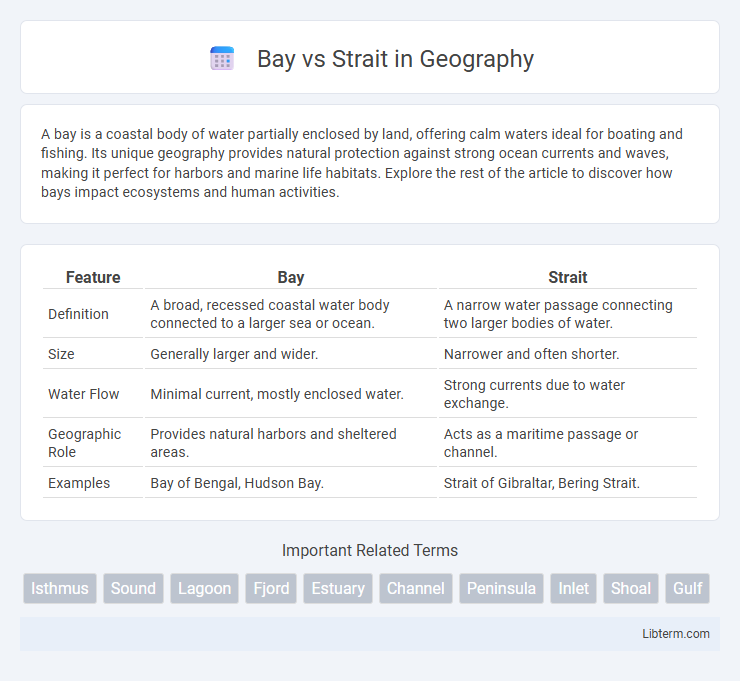A bay is a coastal body of water partially enclosed by land, offering calm waters ideal for boating and fishing. Its unique geography provides natural protection against strong ocean currents and waves, making it perfect for harbors and marine life habitats. Explore the rest of the article to discover how bays impact ecosystems and human activities.
Table of Comparison
| Feature | Bay | Strait |
|---|---|---|
| Definition | A broad, recessed coastal water body connected to a larger sea or ocean. | A narrow water passage connecting two larger bodies of water. |
| Size | Generally larger and wider. | Narrower and often shorter. |
| Water Flow | Minimal current, mostly enclosed water. | Strong currents due to water exchange. |
| Geographic Role | Provides natural harbors and sheltered areas. | Acts as a maritime passage or channel. |
| Examples | Bay of Bengal, Hudson Bay. | Strait of Gibraltar, Bering Strait. |
Introduction to Bays and Straits
A bay is a coastal body of water partially enclosed by land, offering calm waters ideal for ports and harbors, whereas a strait is a narrow passage connecting two larger bodies of water, facilitating marine navigation and trade routes. Bays often serve as natural shelters for ships, supporting ecosystems with sheltered waters, while straits are critical for international shipping and strategic military positioning. Geographic factors such as width, depth, and surrounding landforms distinguish bays from straits and influence their environmental and economic significance.
Defining Bays: Characteristics and Formation
Bays are coastal bodies of water partially enclosed by land, characterized by their wide openings to larger water bodies and calmer waters compared to open oceans. They often form through processes like erosion, glacial activity, or tectonic movements, resulting in distinct shapes that provide natural harbors and habitats. Key features include shallow depths, protected shorelines, and smooth, curved coastlines that distinguish bays from straits and other marine formations.
Understanding Straits: Features and Origins
Straits are narrow, naturally formed waterways that connect two larger bodies of water, often serving as crucial marine passages for shipping and biodiversity. They originate from tectonic activity, erosion, or rising sea levels that submerge land, creating channels between landmasses. Key features include strong tidal currents, varying widths, and strategic geopolitical significance due to their position between continents or islands.
Key Differences Between Bays and Straits
Bays are coastal bodies of water partially enclosed by land, typically providing calm waters ideal for harbors and marine habitats, whereas straits are narrow passages of water connecting two larger bodies of water, often critical for maritime navigation and strategic control. The size and shape of bays tend to be broader and more open, promoting sediment accumulation and biodiversity, while straits are usually narrower with stronger currents and tidal flows influencing their ecosystems. Bays often serve as natural shelters for ships, contrasting with straits, which function as vital channels for international shipping routes and water exchange between seas or oceans.
Ecological Importance of Bays and Straits
Bays serve as critical habitats for diverse marine species due to their sheltered waters, promoting breeding and nurturing of fish, birds, and invertebrates. Straits function as essential migratory pathways, supporting nutrient exchange and ocean circulation that sustain rich biodiversity in adjoining ecosystems. Both bays and straits contribute significantly to coastal productivity, water quality regulation, and resilience against environmental changes.
Strategic and Economic Significance
Bays serve as crucial natural harbors, providing sheltered anchorage for maritime trade and enhancing regional economic activities through port development and fishing industries. Straits function as vital international maritime chokepoints, controlling key shipping lanes and enabling strategic military presence, which affects global trade flow and energy transportation. Control over straits often influences geopolitics and economic security, while bays primarily support local economic infrastructure and coastal urban growth.
Famous Bays Around the World
Famous bays such as San Francisco Bay, Hudson Bay, and Bay of Bengal showcase natural coastal indentations where the sea curves inward, creating sheltered waters ideal for ports and marine ecosystems. Unlike straits, which are narrow passages connecting two larger bodies of water, bays typically offer expansive areas of calm water surrounded by land on three sides. These bays are not only significant for their geographical formations but also for their cultural, economic, and ecological importance globally.
Notable Straits Globally
Notable straits globally include the Strait of Gibraltar, connecting the Atlantic Ocean to the Mediterranean Sea, and the Strait of Malacca, a key maritime passage between the Indian and Pacific Oceans. These narrow waterways differ from bays, which are broader water bodies partially enclosed by land. Straits play a vital role in international shipping and strategic military navigation due to their constrained geography.
Human Activities and Environmental Impact
Bays often serve as hubs for human activities such as shipping, fishing, tourism, and urban development, which can lead to pollution, habitat destruction, and water quality degradation. Straits, being narrow passages connecting larger bodies of water, are vital for international maritime traffic, increasing risks of oil spills and invasive species introduction that threaten marine ecosystems. Both environments require careful management to balance economic benefits with conservation efforts, ensuring sustainable use and protection of aquatic habitats.
Conclusion: Comparing Bays and Straits
Bays are broad, curved coastal bodies of water that provide sheltered environments ideal for ports and marine ecosystems, whereas straits are narrow passages connecting two larger water bodies, often crucial for maritime navigation and strategic control. The geomorphological characteristics of bays promote sediment deposition and biodiversity hotspots, while straits influence ocean currents and serve as critical chokepoints in global shipping routes. Choosing between bays and straits depends on their ecological functions, economic significance, and strategic maritime importance.
Bay Infographic

 libterm.com
libterm.com